
量子效率测试仪
PL/EL一体机
Sinton硅片少子寿命测试仪
Sinton硅块少子寿命测试仪
绒面反射率测试仪
3D共聚焦显微镜
清洗制绒工作站
在线四探针方阻测试仪
全自动扫描四探针方阻测试仪
在线薄膜厚度测试仪
晶化率测试仪
Horiba高速高分辨显微共焦拉曼光谱仪
傅里叶红外光谱仪
霍尔效应测试仪
分光光度计
全光谱椭偏仪
Horiba椭圆偏振光谱仪
TLM接触电阻率测试仪
超景深显微镜
网版智能影像测量仪
全自动影像测量仪
卧式拉力机
电池片稳态光衰老化试验箱
电池片紫外老化试验箱
电池片拉脱力综合测试仪
外观检验台
湿漏电测试系统
组件实验室EL测试仪
紫外老化试验箱
稳态光衰老化试验箱
电流连续性监测系统
PID测试系统
旁路二极管测试系统
LeTID测试系统
反向电流过载系统
脉冲电压测试系统
绝缘耐压测试仪
接地连续性测试仪
绝缘耐压接地测试仪
湿热环境试验箱
湿冻环境试验箱
热循环试验箱
动态机械载荷测试机
静态机械载荷测试机
冰雹冲击试验机
引出端强度试验机
霰弹冲击试验机
抗划伤(切割)测试机
剥离试验机
万能材料试验机(单臂)
万能材料试验机(双臂)
光伏玻璃透过率测试仪
醋酸测试试验箱
交联度测试系统
二极管接线盒综合测试仪
落球冲击试验机
半自动四探针
全自动探针式台阶仪
复合式LED模拟器
多通道太阳能MPPT系统
LED模拟器光浴
Horiba高灵敏一体式稳瞬态荧光光谱仪
钙钛矿P1激光划线测试仪
钙钛矿在线膜厚测试仪
钙钛矿工艺检测工作站
手持式IV测试仪
便携式EL测试仪
手持热成像测试仪
户外组件IV测试仪
户外组件多通道测试系统
光伏逆变器电能质量测试仪
无人机EL检测仪
中国科大徐集贤团队Science:抑制相分离的三卤化物宽带隙钙钛矿可实现高效钙钛矿/硅叠层太阳能电池
日期:2024-10-15浏览量:15
宽带隙金属卤化物钙钛矿是与硅叠层结合使用的理想半导体,以实现超过30%的功率转换效率(PCE),同时降低成本。然而,宽带隙钙钛矿太阳能电池受到光诱导相分离和低开路电压的基本限制。外部量子效率(EQE)测试对于验证三重卤化物宽带隙钙钛矿材料在太阳能电池中应用的性能至关重要。美能量子效率测试仪用于准确测定钙钛矿太阳能电池光谱响应/EQE (IPCE)和IQE。
三卤化物钙钛矿的光电性能
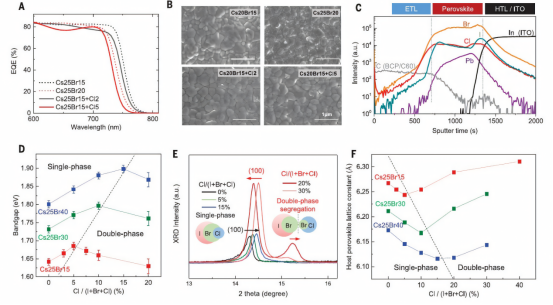
三重卤化物钙钛矿合金的特性
EQE(外部量子效率)测量:
通过形成含2 - 5 mol% Cl 的三卤化物钙钛矿,相对于主体钙钛矿,能带隙得以提高。例如,Cs25Br15 与不同含量的 MAPbCl₃混合后,所形成的薄膜能带隙从 1.63 eV 连续提升到 > 1.67 eV,表明了三卤化物的形成对能带隙有显著影响。
上图从多个方面展示了三卤化物钙钛矿合金的特性,包括 EQE 测量、SEM 图像、TOF - SIMS 深度剖面、能带隙演变曲线以及 XRD 峰的移动与相转变等,这些结果共同揭示了三卤化物钙钛矿的结构和性能特点以及相分离机制。
三重卤化物钙钛矿薄膜中增强的电荷载流子迁移率和寿命
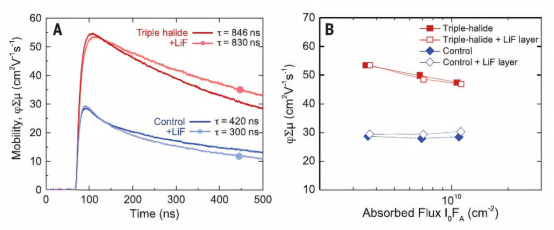
三卤化物钙钛矿薄膜中电荷载流子迁移率和寿命的增强
从图中的时间分辨微波电导率(TRMC)测量结果可知,1.67 - eV 的三卤化物钙钛矿薄膜(Cs22Br15 + Cl3)与对照薄膜(Cs25Br20)相比,电荷载流子寿命显著增加。在吸收光子通量约为 1×10¹⁰ cm⁻²(接近 1 - sun 强度)时,寿命从420 ns增加到846 ns,约为对照样品的两倍。
在不同激发强度下,三卤化物钙钛矿薄膜的电荷载流子迁移率也有明显提高。相对于对照双卤化物薄膜,三卤化物薄膜的迁移率近乎翻倍。
三重卤化物钙钛矿材料中光诱导相分离的抑制效果
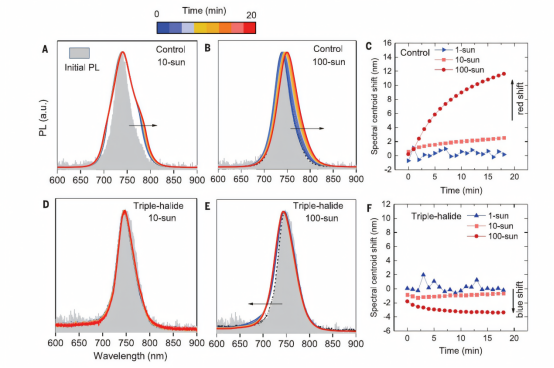
图中可见,钙钛矿薄膜在光照下出现光致相分离现象,且随光照强度增加而加剧。三卤化物钙钛矿在光照下表现出较好的光稳定性,且在高光照强度下出现 PL 光谱蓝移现象。通过对比,直观地证明了三卤化物钙钛矿对光致相分离具有抑制作用,为其在高效太阳能电池中的应用提供了优势。
⾼效稳定的三⻧化物钙钛矿/硅叠层
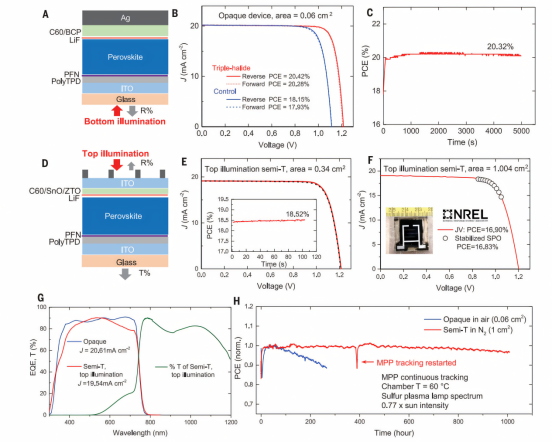
单结不透明电池和半透明顶电池的光伏特性
EQE 光谱与光学性能:不透明电池在较宽的波长范围内具有较高的EQE,而半透明电池在近红外区域具有一定的透明度,同时其 EQE 也能满足一定的性能要求。
长期稳定性测试: 1 - cm² 的半透明电池和不透明电池在加速条件下(0.77 - sun 光照和 60°C)的长期连续最大功率点(MPP)跟踪结果。半透明电池在N₂环境下经过1000 小时的连续MPP操作后,几乎没有降解(<4%),而不透明电池在空气中经过250小时的连续 MPP 操作后,仍能保留90%的初始PCE。
三重卤化物钙钛矿电池在光伏性能上相较于对照组有显著提升,包括更高的PCE、更稳定的操作以及更好的光稳定性。
1 - cm² 双端钙钛矿/硅叠层电池的光伏特性
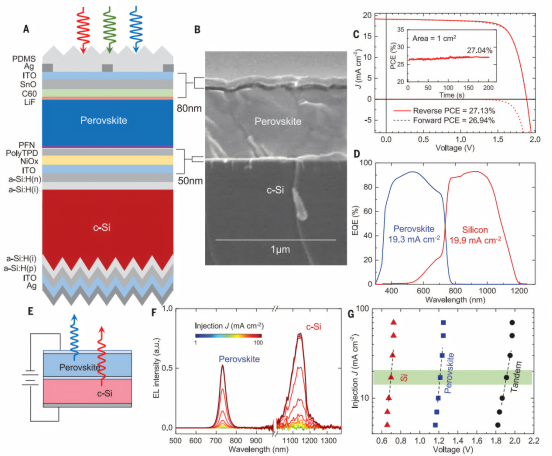
1 - cm² 双端钙钛矿/硅叠层电池的光伏特性
外部量子效率(EQE)光谱:钙钛矿顶电池(蓝色曲线)和硅底电池(红色曲线)的EQE光谱显示了两个子电池在不同波长下的光电转换效率。
EQE光谱表明,钙钛矿和硅子电池的光谱响应是互补的。钙钛矿顶电池在300-500nm和600-900 nm的范围内展现了较高的EQE值,而硅底电池在800-1100 nm的范围内展现了较高的EQE值。
三重卤化物钙钛矿/硅叠层太阳能电池在提高光电转换效率方面具有显著潜力。通过优化钙钛矿顶电池和硅底电池的设计和制造,可以实现超过30%的高效率,这对于推动太阳能技术的发展具有重要意义。
美能量子效率测试仪
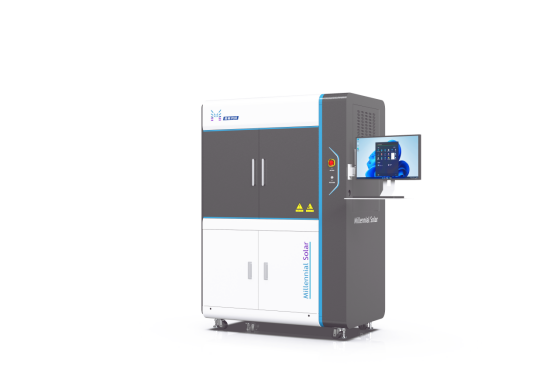
联系电话:400 008 6690
美能MNPVQE-300量子效率测试仪可以兼容测量所有太阳能电池的光谱响应,光谱范围从300nm-2500nm,可以测量EQE、IQE、反射率、透射率和短路电流密度等参数,搭配直径150mm积分球,为让您的光伏研究进展更加顺利。
n 兼容所有太阳能电池类型,满足多种测试需求
n 光谱范围可达300-2500nm,并提供特殊化定制
n 氙灯+卤素灯双光源结构,保证光源稳定性
通过EQE测试的数据和分析,展示了三重卤化物钙钛矿材料在提升太阳能电池性能方面的重要进展,研究人员可以调整材料组分、电池结构和制造工艺,以实现最佳的光电性能和高效率的叠层太阳能电池。美能量子效率测试仪通过精确模拟自然光谱和利用先进的光电技术,不仅提供高精度的测试结果,还能适应各种复杂的电池结构。
原文文献:Triple-halide wide-band gap perovskites withsuppressed phase segregation for efficient tandems(2020,3)






































































